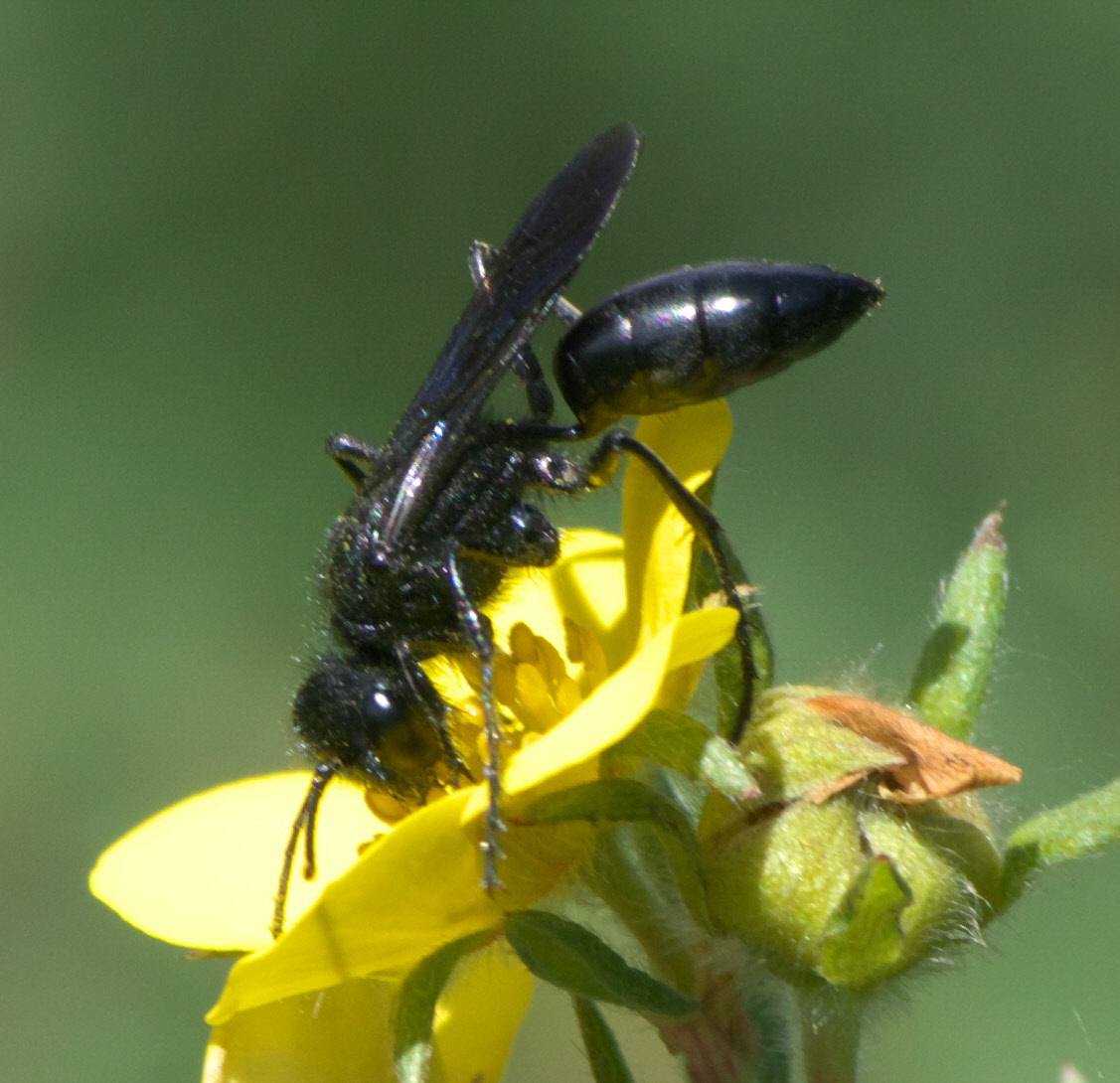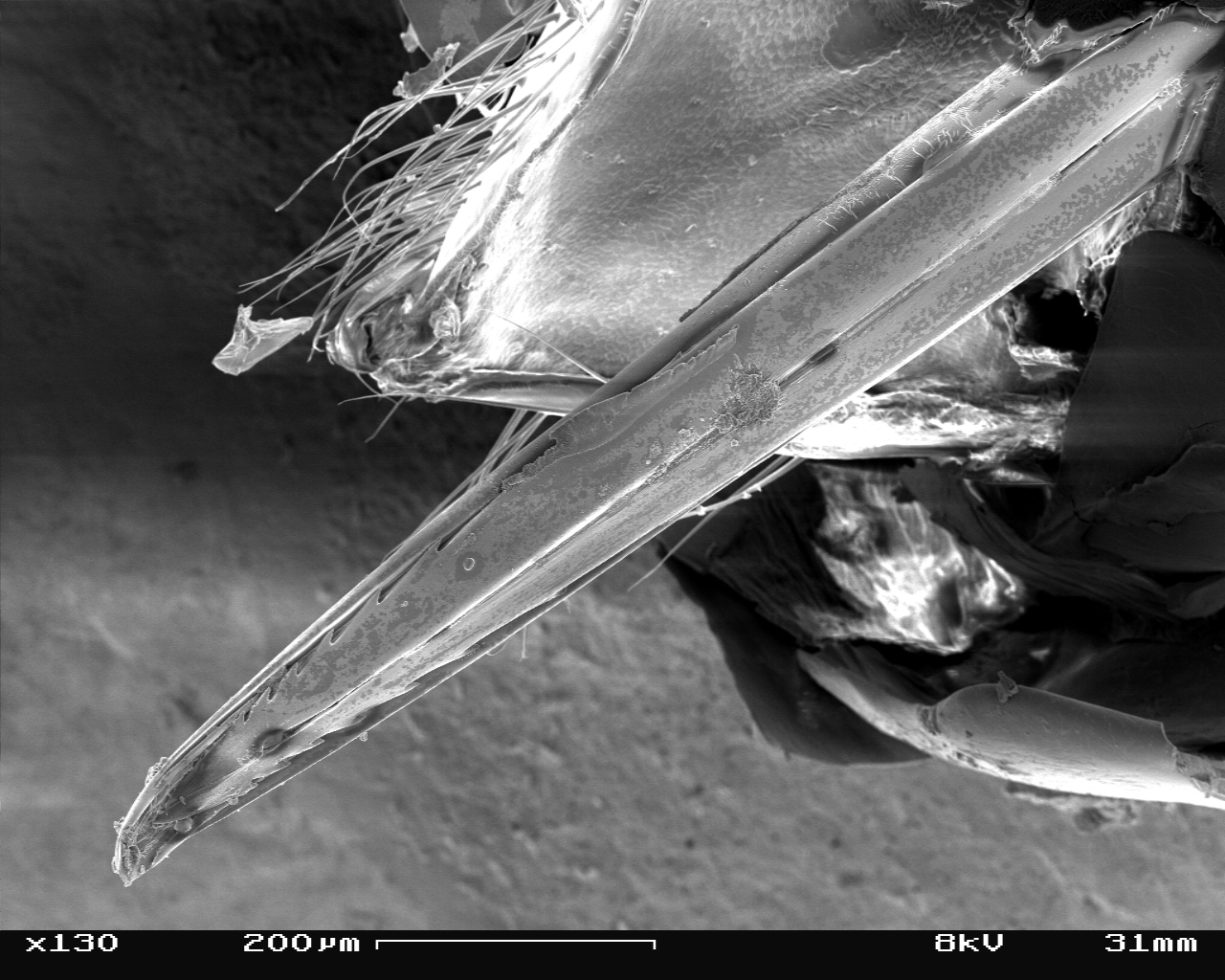|
Cerceris Fumipennis
''Cerceris fumipennis'', the only species of buprestid-hunting Crabronidae occurring in eastern North America, is found throughout the continental United States east of the Rockies: from Texas and Florida north to Maine, Wyoming, and into Canada. The wasps most often nest in open areas of hard-packed sandy soil surrounded by woody habitat suitable for their buprestid beetle prey. Identification ''Cerceris fumipennis'' is distinguished by five conspicuous characteristics: *It is large, about the size of common yellow jacket wasps. *It has dark smoky, blue/black wings. *The wasp's body is predominantly black except for a few yellow markings. *It has a conspicuous, single broad creamy yellow abdominal band. *Females have three creamy patches between the eyes; while males are marked with two yellow triangles abutting their eyes. Biology ''Cerceris fumipennis'' is a solitary ground-nesting wasp. Each lone female constructs and attempts to maintain a single subterranean n ... [...More Info...] [...Related Items...] OR: [Wikipedia] [Google] [Baidu] |
Animal
Animals are multicellular, eukaryotic organisms in the Kingdom (biology), biological kingdom Animalia. With few exceptions, animals Heterotroph, consume organic material, Cellular respiration#Aerobic respiration, breathe oxygen, are Motility, able to move, can Sexual reproduction, reproduce sexually, and go through an ontogenetic stage in which their body consists of a hollow sphere of Cell (biology), cells, the blastula, during Embryogenesis, embryonic development. Over 1.5 million Extant taxon, living animal species have been Species description, described—of which around 1 million are Insecta, insects—but it has been estimated there are over 7 million animal species in total. Animals range in length from to . They have Ecology, complex interactions with each other and their environments, forming intricate food webs. The scientific study of animals is known as zoology. Most living animal species are in Bilateria, a clade whose members have a Symmetry in biology#Bilate ... [...More Info...] [...Related Items...] OR: [Wikipedia] [Google] [Baidu] |
Cerceris Fumipennis Male Face
__NOTOC__ ''Cerceris'' is a genus of wasps in the family Crabronidae. It is the largest genus in the family, with over 1030 described species and subspecies. Cerceris Catalog The genus has a , with species on every continent.Genaro, J. A. (2004) A new species of ''Cerceris'' from Hispaniola, West Indies (Hymenoptera: Crabronidae: Philanthinae). ''Journal of the Kansas Entomological ... [...More Info...] [...Related Items...] OR: [Wikipedia] [Google] [Baidu] |
Hymenoptera Of North America
Hymenoptera is a large order of insects, comprising the sawflies, wasps, bees, and ants. Over 150,000 living species of Hymenoptera have been described, in addition to over 2,000 extinct ones. Many of the species are parasitic. Females typically have a special ovipositor for inserting eggs into hosts or places that are otherwise inaccessible. This ovipositor is often modified into a stinger. The young develop through holometabolism (complete metamorphosis)—that is, they have a wormlike larval stage and an inactive pupal stage before they mature. Etymology The name Hymenoptera refers to the wings of the insects, but the original derivation is ambiguous. All references agree that the derivation involves the Ancient Greek πτερόν (''pteron'') for wing. The Ancient Greek ὑμήν (''hymen'') for membrane provides a plausible etymology for the term because species in this order have membranous wings. However, a key characteristic of this order is that the hindwings are co ... [...More Info...] [...Related Items...] OR: [Wikipedia] [Google] [Baidu] |
Agrilus Planipennis
The emerald ash borer (''Agrilus planipennis''), also known by the acronym EAB, is a green buprestid or jewel beetle native to north-eastern Asia that feeds on ash species. Females lay eggs in bark crevices on ash trees, and larvae feed underneath the bark of ash trees to emerge as adults in one to two years. In its native range, it is typically found at low densities and does not cause significant damage to trees native to the area. Outside its native range, it is an invasive species and is highly destructive to ash trees native to Europe and North America. Before it was found in North America, very little was known about emerald ash borer in its native range; this has resulted in much of the research on its biology being focused in North America. Local governments in North America are attempting to control it by monitoring its spread, diversifying tree species, and through the use of insecticides and biological control. History French priest and naturalist Armand David co ... [...More Info...] [...Related Items...] OR: [Wikipedia] [Google] [Baidu] |
Mass Provisioning
Mass provisioning is a form of parental investment in which an adult insect, most commonly a hymenopteran such as a bee or wasp, stocks all the food for each of her offspring in a small chamber (a "cell") before she lays the egg. This behavior is common in both solitary and eusocial bees, though essentially absent in eusocial wasps. Diversity In bees, stored provisions typically consist of masses of mixed pollen and nectar, though a few species store floral oils. In a few cases, such as stingless bees and some sweat bees, the number of cells in a single nest can number in the hundreds to thousands, but more typically a nest contains either a single cell, or a small number (fewer than 10). In predatory wasps, the food is typically in the form of paralyzed or dead prey items; after digging the nest they quickly catch one or a few prey animals, bring them to the nest and lay eggs on them, seal the nest and leave. Some wasp lineages (e.g. Crabronidae) show variation, with some spe ... [...More Info...] [...Related Items...] OR: [Wikipedia] [Google] [Baidu] |
Sphecid
The Sphecidae are a cosmopolitan family of wasps of the suborder Apocrita that includes sand wasps, mud daubers, and other thread-waisted wasps. The name Sphecidae was formerly given to a much larger grouping of wasps. This was found to be paraphyletic, so most of the old subfamilies have been moved to the Crabronidae. Biology The biology of the Sphecidae, even under the restricted definition, is still fairly diverse; some sceliphrines even display rudimentary forms of sociality, and some sphecines rear multiple larvae in a single large brood cell. Many nest in pre-existing cavities, or dig simple burrows in the soil, but some species construct free-standing nests of mud and even (in one genus) resin. All are predatory and parasitoidal, but the type of prey ranges from spiders to various dictyopterans, orthopteroids and larvae of either Lepidoptera or other Hymenoptera; the vast majority practice mass provisioning, providing all the prey items prior to laying the egg. ... [...More Info...] [...Related Items...] OR: [Wikipedia] [Google] [Baidu] |
Crabronidae
The Crabronidae are a large paraphyletic group (nominally a family) of wasps, including nearly all of the species formerly comprising the now-defunct superfamily Sphecoidea. It collectively includes well over 200 genera, containing well over 9000 species. Crabronids were originally a part of Sphecidae, but the latter name is now restricted to a separate family based on what was once the subfamily Sphecinae. Several of the subfamilies of Crabronidae are often treated as families in their own right, as is true of the most recent phylogenies (example below). Phylogeny This phylogenetic tree is based on Sann ''et al.'', 2018, which used phylogenomics to demonstrate that both the bees (Anthophila) and the Sphecidae arose from within the former Crabronidae, which is therefore paraphyletic, and which they suggested should be split into several families; the former family Heterogynaidae nests within the Bembicidae, as here defined. These findings differ in several details from studie ... [...More Info...] [...Related Items...] OR: [Wikipedia] [Google] [Baidu] |
Yellow Jacket
Yellowjacket or yellowjacket is the common name in North America for predatory social wasps of the genera ''Vespula'' and ''Dolichovespula''. Members of these genera are known simply as "wasps" in other English-speaking countries. Most of these are black and yellow like the eastern yellowjacket ''Vespula maculifrons'' and the aerial yellowjacket ''Dolichovespula arenaria''; some are black and white like the bald-faced hornet, ''Dolichovespula maculata''. Others may have the abdomen background color red instead of black. They can be identified by their distinctive markings, their occurrence only in colonies, and a characteristic, rapid, side-to-side flight pattern prior to landing. All females are capable of stinging. Yellowjackets are important predators of pest insects. Identification Yellowjackets may be confused with other wasps, such as hornets and paper wasps such as ''Polistes dominula''. A typical yellowjacket worker is about long, with alternating bands on the abdo ... [...More Info...] [...Related Items...] OR: [Wikipedia] [Google] [Baidu] |
Cerceris Fumipennis Female Face
__NOTOC__ ''Cerceris'' is a genus of wasps in the family Crabronidae. It is the largest genus in the family, with over 1030 described species and subspecies. Cerceris Catalog The genus has a , with species on every continent.Genaro, J. A. (2004) A new species of ''Cerceris'' from Hispaniola, West Indies (Hymenoptera: Crabronidae: Philanthinae). ''Journal of the Kansas Entomological ... [...More Info...] [...Related Items...] OR: [Wikipedia] [Google] [Baidu] |
Arthropod
Arthropods (, (gen. ποδός)) are invertebrate animals with an exoskeleton, a Segmentation (biology), segmented body, and paired jointed appendages. Arthropods form the phylum Arthropoda. They are distinguished by their jointed limbs and Arthropod cuticle, cuticle made of chitin, often Mineralization (biology), mineralised with calcium carbonate. The arthropod body plan consists of segments, each with a pair of appendages. Arthropods are bilaterally symmetrical and their body possesses an exoskeleton, external skeleton. In order to keep growing, they must go through stages of moulting, a process by which they shed their exoskeleton to reveal a new one. Some species have wings. They are an extremely diverse group, with up to 10 million species. The haemocoel, an arthropod's internal cavity, through which its haemolymph – analogue of blood – circulates, accommodates its interior Organ (anatomy), organs; it has an open circulatory system. Like their exteriors, the internal or ... [...More Info...] [...Related Items...] OR: [Wikipedia] [Google] [Baidu] |







